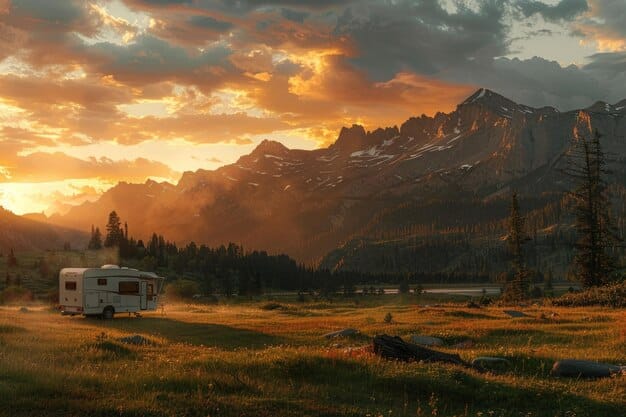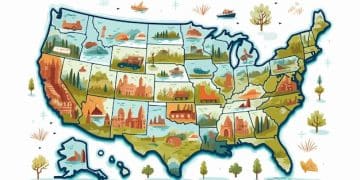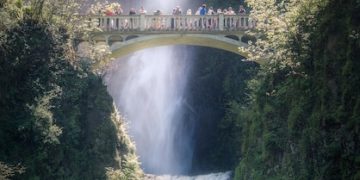RV Travel in the US: The Ultimate Guide for All Road Trippers

Anúncios
The Ultimate Guide to RV Travel in the US provides comprehensive tips, from planning your route and choosing the right RV to essential packing and safety advice for both novice and experienced road trippers, ensuring a memorable and hassle-free adventure.
Embarking on an RV adventure across the United States is a dream for many, offering unparalleled freedom and the chance to explore breathtaking landscapes. The Ultimate Guide to RV Travel in the US: Tips for Beginners and Seasoned Road Trippers Alike is designed to equip you with all the knowledge you need to make that dream a reality, whether you’re a first-timer or a seasoned road warrior.
Anúncios
Planning Your RV Trip: The Foundation for Success
Before you hit the open road, meticulous planning is crucial for a smooth and enjoyable RV trip. This involves everything from choosing the right route to understanding the best time to travel, considering your budget, and making reservations at campgrounds or RV parks.
Choosing Your Route and Destinations
The United States boasts an array of incredible destinations, each offering unique experiences. Consider what you want to see and do, then map out a route that aligns with your interests.
Anúncios
- National Parks: From the Grand Canyon to Yellowstone, explore America’s natural wonders.
- Coastal Highways: Drive along the Pacific Coast Highway or the scenic Route 1 in Maine.
- Historical Sites: Visit landmarks like Colonial Williamsburg or Gettysburg.
- Urban Adventures: Explore cities like New Orleans, San Francisco, or Austin.
Remember to factor in driving distances and potential traffic delays. Apps like Roadtrippers and RV Trip Wizard can help you plan your route efficiently.
Budgeting for Your RV Adventure
RV travel can be cost-effective, but it’s essential to create a realistic budget. Consider these expenses:
- Fuel: RVs can be gas-guzzlers, so factor in fuel costs based on your planned mileage.
- Campground Fees: Prices vary depending on amenities and location.
- Food: Cooking your own meals can save money compared to eating out every day.
- Activities: Include costs for entrance fees, tours, and other activities.
Don’t forget to set aside a contingency fund for unexpected expenses, such as repairs or medical emergencies.
Effective planning lays the groundwork for a successful RV trip, allowing you to maximize your enjoyment. By carefully considering your route, budget, and other essential factors, you can set the stage for an unforgettable adventure across the United States.
Choosing the Right RV: Finding Your Perfect Home on Wheels
Selecting the right RV is a pivotal decision that can significantly impact your travel experience. Different RV types cater to various needs and preferences, so it’s important to understand the options available.
Types of RVs: A Comprehensive Overview
From compact campervans to luxurious Class A motorhomes, the choices can seem overwhelming. Here’s a breakdown of common RV types:
- Class A Motorhomes: These are the largest and most luxurious RVs, offering ample living space and amenities.
- Class B Motorhomes (Campervans): These are smaller and more agile, ideal for solo travelers or couples who value maneuverability.
- Class C Motorhomes: These offer a balance of space and convenience, built on a van chassis with an over-cab sleeping area.
- Travel Trailers: These are towed behind a vehicle, providing flexibility as you can unhitch and explore your destination.
- Fifth Wheel Trailers: These are similar to travel trailers but attach to a pickup truck bed, offering greater stability.

Consider factors like the number of people traveling, your budget, and the type of terrain you plan to navigate when making your selection.
Renting vs. Buying: Weighing the Options
Deciding whether to rent or buy an RV depends on your travel frequency and long-term goals. Renting allows you to try out different RV types without a significant investment, while buying may be more cost-effective for frequent travelers.
When renting, research reputable rental companies and carefully inspect the RV before you leave. When buying, consider both new and used options, and be sure to have a mechanic inspect the RV before making a purchase.
Choosing the right RV involves understanding your needs and weighing the advantages of renting versus buying. By considering these factors, you can ensure that your home on wheels enhances your travel experience.
Packing Essentials for RV Travel: What to Bring and What to Leave Behind
Packing efficiently is an art when it comes to RV travel. Space is limited, so it’s crucial to bring only what you need, ensuring you have everything for a comfortable and safe journey.
Essential Gear and Supplies
Start with the basics and add from there. Here are some must-have items:
- Bedding and Linens: Comfortable bedding is essential for a good night’s sleep.
- Kitchen Supplies: Pots, pans, utensils, and dishes for cooking your own meals.
- First Aid Kit: Stocked with bandages, antiseptic wipes, pain relievers, and any personal medications.
- Tools and Repair Kit: Basic tools for minor repairs and maintenance.
Remember to pack clothing appropriate for the climate and activities you plan to pursue. Layering is often the best approach.
Optimizing Space: Smart Packing Techniques
Maximize your limited space with these clever packing strategies:
- Roll Your Clothes: This saves space compared to folding.
- Use Packing Cubes: These keep your belongings organized and compressed.
- Utilize Vertical Space: Shelves and organizers can make the most of available storage.
- Invest in Multi-Purpose Items: A single item that serves multiple functions saves space and weight.
By packing smartly and prioritizing essentials, you can create a comfortable and organized living space in your RV.
Efficient packing is crucial for a comfortable RV trip. By bringing essential supplies and employing smart packing techniques, you can maximize your space and minimize stress on the road.
RV Safety and Maintenance: Ensuring a Smooth and Secure Journey
Prioritizing safety and maintenance is paramount when embarking on an RV adventure. Regular checks, proper driving techniques, and emergency preparedness can significantly reduce risks.
Pre-Trip Inspections and Maintenance
Before each trip, conduct a thorough inspection of your RV. Check the following:
- Tires: Inspect for wear and tear and ensure proper inflation.
- Brakes: Verify that brakes are functioning correctly.
- Lights: Ensure all lights are working, including headlights, taillights, and turn signals.
- Fluid Levels: Check oil, coolant, brake fluid, and windshield washer fluid.

Regular maintenance, such as oil changes and brake inspections, can prevent costly repairs down the road.
Safe Driving Practices for RVs
Driving an RV requires different techniques than driving a car. Keep these tips in mind:
- Allow Extra Following Distance: RVs require more time to stop.
- Take Wide Turns: Avoid clipping curbs or obstacles.
- Be Mindful of Height Restrictions: Pay attention to bridge and overpass clearances.
- Use Mirrors Effectively: Practice using your mirrors for maximum visibility.
Driving safely is paramount. By being aware of the unique challenges of RV driving, you can minimize risks and enjoy a safer journey.
By prioritizing safety and maintenance, you can ensure a smooth and secure RV trip. Regular inspections, safe driving practices, and emergency preparedness are essential for protecting yourself and your fellow travelers.
Finding the Perfect Campsite: Tips for Booking and Enjoying Your Stay
Finding the right campsite is a crucial aspect of RV travel. Whether you prefer developed campgrounds or dispersed camping, understanding the options enhances your experience.
Types of Campsites: A Comparison
Choosing between different types of campsites can significantly affect your trip.
- Developed Campgrounds: These offer amenities like hookups, restrooms, and showers. Reservations are often required.
- RV Parks: Privately owned, these usually feature full hookups, recreational facilities, and organized activities.
- Dispersed Camping (Boondocking): Camping in designated areas without amenities, often free but requiring self-sufficiency.
Consider what amenities are important to you and your comfort level when making your choice.
Booking Your Campsite: Strategies and Tips
Securing a campsite, especially during peak season, requires planning.
- Book in Advance: Reservations can often be made months in advance.
- Use Online Resources: Websites like Recreation.gov and ReserveAmerica allow you to search and book campsites.
- Consider Weekday Stays: Campsites are often less crowded during the week.
Be sure to read reviews and check the campsite’s policies before booking.
Finding the perfect campsite requires research and planning. By exploring different options and booking strategically, you can ensure a comfortable and enjoyable stay at each stop on your RV journey.
Embracing the RV Lifestyle: Tips for Seasoned Road Trippers
For those who have embraced the RV lifestyle, there are always new ways to enhance the experience. From connecting with fellow travelers to optimizing your rig, continuous improvement is key.
Connecting with the RV Community
One of the joys of RV travel is the sense of community.
- Join RV Clubs: Organizations like Good Sam and Escapees offer resources, discounts, and social events.
- Attend RV Rallies: These gatherings provide opportunities to meet other RVers, learn new skills, and share experiences.
- Engage Online: Forums and social media groups connect RVers from around the world.
By connecting with others, you can gain valuable insights and build lasting friendships.
Continuous Improvement: Tips for Seasoned RVers
Even experienced RVers can benefit from continuous learning and upgrades.
- Upgrade Your RV: Consider adding solar panels, a satellite dish, or other amenities.
- Learn New Skills: Take courses on RV maintenance, safety, or travel photography.
- Explore New Destinations: Venture off the beaten path and discover hidden gems.
Embracing the RV lifestyle is about continuous learning and exploration. By staying connected, improving your skills, and seeking out new experiences, you can make the most of your time on the road.
| Key Point | Brief Description |
|---|---|
| 🗺️ Route Planning | Choose destinations, budget fuel, and book campgrounds in advance. |
| 🚐 RV Selection | Decide between renting or buying based on travel frequency. |
| 🧳 Packing Essentials | Pack bedding, kitchen supplies, and a first aid kit. |
| 🛠️ Safety & Maintenance | Check tires, brakes, and fluid levels before each trip. |
Frequently Asked Questions
▼
Class C RVs are often recommended for beginners due to their balance of size, maneuverability, and included amenities. They are easier to drive than larger Class A models and offer a good range of features without being overwhelming.
▼
It’s best to book campsites as early as possible, especially if you plan to travel during peak seasons or visit popular destinations. Booking several months in advance can help ensure you get your preferred spot at the campgrounds you desire.
▼
Essential safety items include a well-stocked first-aid kit, a fire extinguisher, carbon monoxide and smoke detectors, a tool kit for minor repairs, and emergency roadside assistance. Ensure these are easily accessible and regularly checked.
▼
To save money, cook your own meals instead of eating out, stay at campgrounds with fewer amenities, travel during the off-season, and take advantage of RV club discounts. Monitoring fuel prices and driving efficiently will also help.
▼
Use RV-specific GPS apps and route planning tools that consider your RV’s height and weight to avoid low clearances and weight-restricted routes. Plan routes ahead of time and always pay attention to road signs.
Conclusion
The Ultimate Guide to RV Travel in the US provides a roadmap for unforgettable adventures, blending the thrill of exploration with the comforts of home. Whether you’re drawn to majestic national parks or vibrant urban landscapes, RV travel offers a unique way to experience the diversity and beauty of the United States.





